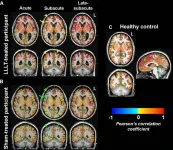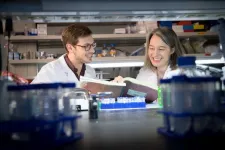(Press-News.org) OAK BROOK, Ill. – Low-level light therapy appears to affect healing in the brains of people who suffered significant brain injuries, according to a study published today in Radiology, a journal of the Radiological Society of North America (RSNA).
Lights of different wavelengths have been studied for years for their wound-healing properties. Researchers at Massachusetts General Hospital (MGH) conducted low-level light therapy on 38 patients who had suffered moderate traumatic brain injury, an injury to the head serious enough to alter cognition and/or be visible on a brain scan. Patients received light therapy within 72 hours of their injuries through a helmet that emits near-infrared light.
“The skull is quite transparent to near-infrared light,” said study co-lead author Rajiv Gupta, M.D., Ph.D., from the Department of Radiology at MGH. “Once you put the helmet on, your whole brain is bathing in this light.”
The researchers used an imaging technique called functional MRI to gauge the effects of the light therapy. They focused on the brain’s resting-state functional connectivity, the communication between brain regions that occurs when a person is at rest and not engaged in a specific task. The researchers compared MRI results during three recovery phases: the acute phase of within one week after injury, the subacute phase of two to three weeks post-injury and the late-subacute phase of three months after injury.
Of the 38 patients in the trial, 21 did not receive light therapy while wearing the helmet. This was done to serve as a control to minimize bias due to patient characteristics and to avoid potential placebo effects.
Patients who received low-level light therapy showed a greater change in resting-state connectivity in seven brain region pairs during the acute-to-subacute recovery phase compared to the control participants.
“There was increased connectivity in those receiving light treatment, primarily within the first two weeks,” said study coauthor Nathaniel Mercaldo, Ph.D., a statistician with MGH. “We were unable to detect differences in connectivity between the two treatment groups long term, so although the treatment appears to increase the brain connectivity initially, its long-term effects are still to be determined.”
The precise mechanism of the light therapy’s effects on the brain is also still to be determined. Previous research points to the alteration of an enzyme in the cell’s mitochondria (often referred to as the “powerhouse” of a cell), Dr. Gupta said. This leads to more production of adenosine triphosphate, a molecule that stores and transfers energy in the cells. Light therapy has also been linked with blood vessel dilation and anti-inflammatory effects.
“There is still a lot of work to be done to understand the exact physiological mechanism behind these effects,” said study coauthor Suk-tak Chan, Ph.D., a biomedical engineer at MGH.
While connectivity increased for the light therapy-treated patients during the acute to subacute phases, there was no evidence of a difference in clinical outcomes between the treated and control participants. Additional studies with larger cohorts of patients and correlative imaging beyond three months may help determine the therapeutic role of light in traumatic brain injury.
The researchers expect the role of light therapy to expand as more study results come in. The 810-nanometer-wavelength light used in the study is already employed in various therapeutic applications. It’s safe, easy to administer and does not require surgery or medications. The helmet’s portability means it can be delivered in settings outside of the hospital. It may have applications in treating many other neurological conditions, according to Dr. Gupta.
“There are lots of disorders of connectivity, mostly in psychiatry, where this intervention may have a role,” he said. “PTSD, depression, autism: these are all promising areas for light therapy.”
###
“Effects of Low-Level Light Therapy on Resting-State Connectivity Following Moderate Traumatic Brain Injury: Secondary Analyses of a Double-blinded, Placebo-controlled Study.” Collaborating with Drs. Gupta, Mercaldo and Chan were Maria G. Figueiro Longo, M.D., Jonathan Welt, M.D., Arman Avesta, M.D., Jarone Lee, M.D., Michael H. Lev, M.D., Eva-Maria Ratai, Ph.D., Michael R. Wenke, B.S., Blair A. Parry, B.A., Lynn Drake, M.D., Richard R. Anderson, M.D., Terry Rauch, Ph.D., Ramon Diaz-Arrastia, M.D., Kenneth K. Kwong, Ph.D., Michael Hamblin, Ph.D., and Benjamin Vakoc, Ph.D.
Radiology is edited by Linda Moy, M.D., New York University, New York, N.Y., and owned and published by the Radiological Society of North America, Inc. (https://pubs.rsna.org/journal/radiology)
RSNA is an association of radiologists, radiation oncologists, medical physicists and related scientists promoting excellence in patient care and health care delivery through education, research and technologic innovation. The Society is based in Oak Brook, Illinois. (RSNA.org)
For patient-friendly information on brain MRI, visit RadiologyInfo.org.
END
Background and Goal: Team-based care is considered the gold standard in delivery models. It uses integrated clinical teams with diverse skills and perspectives to provide efficient, high-quality health care services. Within these teams, individuals from minoritized racial-ethnic groups, often referred to as persons of color (POC), typically occupy roles with less authority (e.g., medical assistants), while white individuals more frequently hold positions of greater power (e.g., physicians). Few studies have explored the viewpoints of staff members in lower-power roles, who are disproportionately POC and constitute the majority of a health care team. This study aims to ...
NRG Oncology (NRG), a National Cancer Institute (NCI) National Clinical Trials Network (NCTN) group focused on improving outcomes for adults with cancer through multi-center clinical research, recently announced two new Vice-Chairs to co-lead the NRG Patient Advocate Committee (PAC) alongside the current PAC Committee Chair, Dorothy Erlanger.
Marlyn Molero, was appointed as Vice-Chair of the NRG PAC. Marlyn is a clinical researcher in the oncology area with Commonspirit Research Institute as well as a Spanish interpreter at Vituity. Marlyn brings a unique perspective to the NRG PAC leadership ...
The toe tapping behavior of various amphibians has long attracted attention from researchers and pet owners. Despite being widely documented, the underlying functional role is poorly understood. In a new paper, researchers demonstrate that Dyeing poison frogs modulate their taps based on specific stimuli.
Dyeing poison frogs, Dendrobates tinctorius, have been shown to tap their posterior toes in response to a range of prey sizes, from small fruit flies to large crickets. In the present study, ...
Irvine, Calif., May 28, 2024 — A multidisciplinary research team at the University of California, Irvine has revealed that the circadian clock – the biological pacemaker that governs daily rhythms in physiological processes, including immune functions – can be leveraged to enhance the efficacy of checkpoint inhibitor cancer therapy. Checkpoint inhibitors block different proteins from binding to tumor cells, allowing the immune system’s T cells to kill the tumor.
The study, published online ...
(MEMPHIS, Tenn. – May 27, 2024) As gene sequencing technologies become more powerful, our understanding of cellular diversity has grown in parallel. This led scientists at St. Jude Children’s Research Hospital to create a tool to improve the ease and accuracy with which investigators can study specific subpopulations of cells. The tool, named Conditional Viral Expression by Ribozyme Guided Degradation (ConVERGD), allows researchers to specifically access these subgroups of cells and precisely manipulate ...
Researchers at the University of California, Davis, have updated their guidelines on when to neuter 40 popular dog varieties by breed and sex. Their recent paper in Frontiers in Veterinary Science adds five breeds to a line of research that began in 2013 with a study that suggested that early neutering of golden retrievers puts them at increased risk of joint diseases and certain cancers.
That initial study set off a flurry of debate about the best age to neuter other popular breeds. Professors Lynette and Benjamin Hart of the School of Veterinary Medicine, the study’s lead authors, set out to add more breed studies by examining more than a decade ...
Music and speech are among the most frequent types of sounds we hear. But how do we identify what we think are differences between the two?
An international team of researchers mapped out this process through a series of experiments—yielding insights that offer a potential means to optimize therapeutic programs that use music to regain the ability to speak in addressing aphasia. This language disorder afflicts more than 1 in 300 Americans each year, including Wendy Williams and Bruce Willis.
“Although music and speech are different in many ways, ranging from pitch to timbre to sound texture, ...
An inexpensive, accurate test that detects infections with the parasite Toxoplasma gondii can provide results within 30 minutes from a finger-prick in a doctor’s office or within an hour from a small blood sample tested in a local medical laboratory. The new test can also identify false positives in other types of commercial diagnostic tests for toxoplasmosis, providing swift reassurance to uninfected pregnant women and their doctors and facilitating timely interventions to protect a fetus against toxoplasmosis in acutely infected pregnant mothers.
These findings appear in a study, led by toxoplasmosis specialist Rima McLeod, MD, ...
Within the family of cell membrane lipids known as phosphoinositides and the kinase enzymes that regulate them, phosphoinositide 3-kinases (PI3Ks) have been cast in a starring role as scientists study their involvement in cancer, diabetes and many cellular activities.
The presence of PI3Ks in the scientific limelight has overshadowed other members of this lipid enzyme family, including phosphatidylinositol-5-phosphate 4-kinases (PI5P4Ks). Brooke Emerling, Ph.D., co-director of, and associate professor in, the Cancer Metabolism and Microenvironment Program at Sanford Burnham Prebys, is contributing to a revival of interest in this underappreciated set of enzymes.
Emerling and team have ...
Health care workers have reported spikes in feeling burnt out in the time since the COVID-19 pandemic began, with nearly half saying it took a toll in 2022 compared to 32 percent in 2018. But a new study shows that easy-to-use and accessible platforms may help reverse this trend. Regular, automated text message reminders connecting staff to a mental health platform called “Cobalt,” drove significant improvements in both depression and anxiety scores among employees, according to a new JAMA Network Open study from the Perelman School of Medicine at the University of Pennsylvania.
“What we found shows ...



